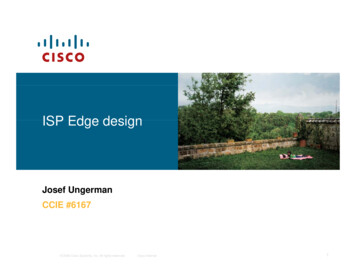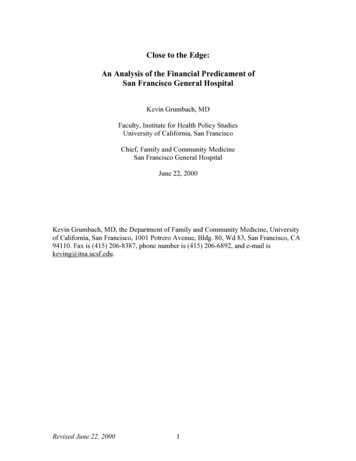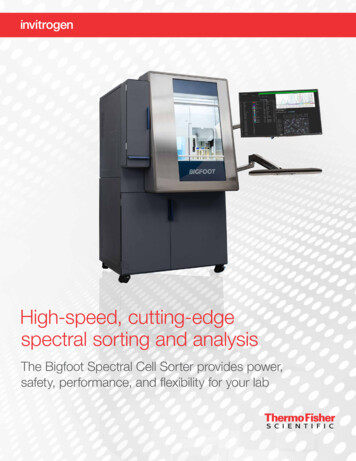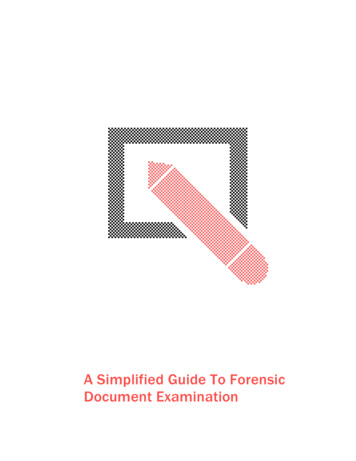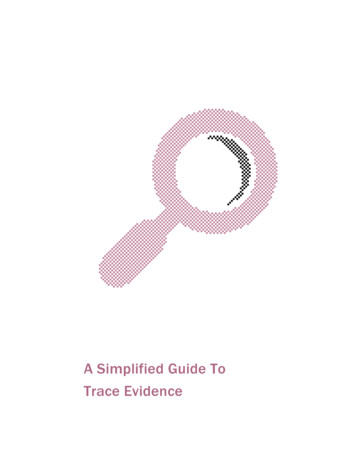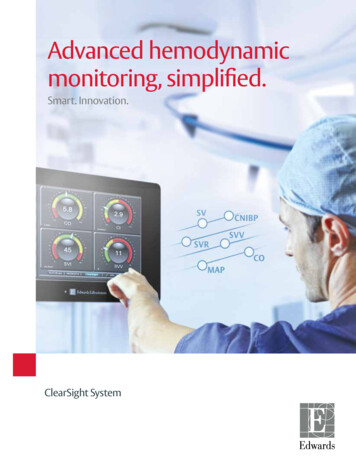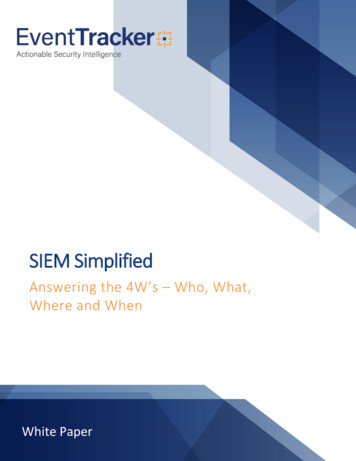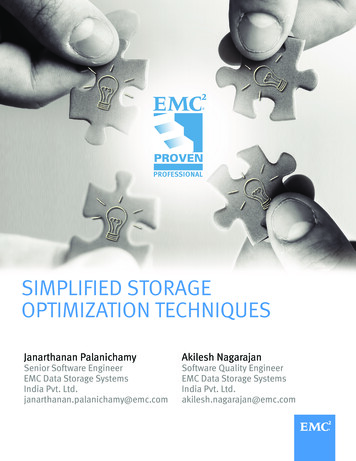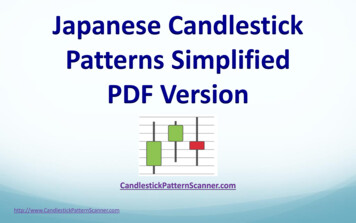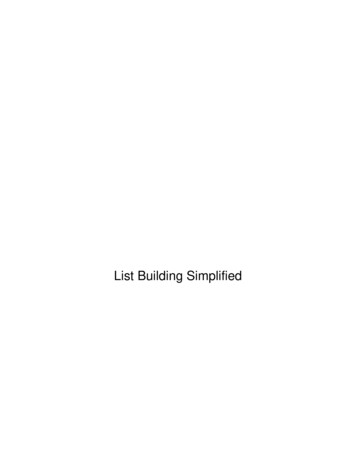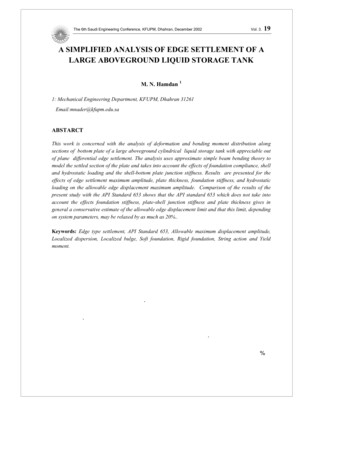
Transcription
Table Of ContentsSearchThe 6th Saudi Engineering Conference, KFUPM, Dhahran, December 2002Author IndexVol. 3.19A SIMPLIFIED ANALYSIS OF EDGE SETTLEMENT OF ALARGE ABOVEGROUND LIQUID STORAGE TANKM. N. Hamdan 11: Mechanical Engineering Department, KFUPM, Dhahran 31261Email:mnader@kfupm.edu.saABSTARCTThis work is concerned with the analysis of deformation and bending moment distribution alongsections of bottom plate of a large aboveground cylindrical liquid storage tank with appreciable outof plane differential edge settlement. The analysis uses approximate simple beam bending theory tomodel the settled section of the plate and takes into account the effects of foundation compliance, shelland hydrostatic loading and the shell-bottom plate junction stiffness. Results are presented for theeffects of edge settlement maximum amplitude, plate thickness, foundation stiffness, and hydrostaticloading on the allowable edge displacement maximum amplitude. Comparison of the results of thepresent study with the API Standard 653 shows that the API standard 653 which does not take intoaccount the effects foundation stiffness, plate-shell junction stiffness and plate thickness gives ingeneral a conservative estimate of the allowable edge displacement limit and that this limit, dependingon system parameters, may be relaxed by as much as 20%.Keywords: Edge type settlement, API Standard 653, Allowable maximum displacement amplitude,Localized dispersion, Localized bulge, Soft foundation, Rigid foundation, String action and Yieldmoment. ﺍﻟﻤﻠﺨﺹ ﻴﻬﺘﻡ ﻫﺫﺍ ﺍﻟﺒﺤﺙ ﺒﺘﺤﻠﻴل ﺍﻟﻨﺸﻭﺓ ﻭﺠﻬﺔ ﺍﻻﻨﺤﻨﺎﺀ ﺍﻟﻤﺭﺍﻓﻕ ﻟﻪ ﻋﻠﻲ ﻁﻭل ﻤﻘﺎﻁﻊ ﻤﻥ ﻤﻨﻁﻘﺔ ﺍﻻﺴﺘﻘﺭﺍﺭ ﺍﻟﺠﺎﻨﺒﻲ ﺍﻟﻼﺴﻁﺤﻲ ﻓﻲ ﻴﺴﺘﺨﺩﻡ ﻫﺫﺍ ﺍﻟﺒﺤﺙ ﻨﻅﺭﻴﺔ ﺃﻨﺤﺎﺀ ﺍﻟﻌﻭﺍﺭﺽ ﺍﻟﺴﻬﻠﺔ . ﺍﻟﺼﻔﻴﺤﺔ ﺍﻟﺴﻔﻠﻴﺔ ﻟﺨﺯﺍﻨﺎﺕ ﺍﻟﺴﻭﺍﺌل ﺃﺴﻁﻭﺍﻨﻴﺔ ﺍﻟﺸﻜل ﺫﻭ ﺍﻟﺤﺠﻡ ﺍﻟﻜﺒﻴﺭ ﻟﺘﻤﺜﻴل ﺍﻻﺴﺘﻘﺭﺍﺭ ﺍﻟﺠﺎﻨﺒﻲ ﻓﻲ ﺍﻟﺼﻔﻴﺤﺔ ﺍﻟﺴﻔﻠﻴﺔ ﻟﻠﺨﺯﺍﻥ ﺃﺨﺫﺍ ﺒﻌﻴﻥ ﺍﻻﻋﺘﺒﺎﺭ ﺘﺄﺜﻴﺭ ﻟﻴﻭﻨﺔ ﺃﺭﻀﻴﺔ ﻭﻗﺎﻋﺩﺓ ﺍﻟﺨﺯﺍﻥ ﻭﺍﻟﺤﻤﻭﻟﺔ ﻴﻘﺩﻡ ﻫﺫﺍ ﺍﻟﺒﺤﺙ . ﺍﻟﻨﺎﺘﺠﺔ ﻋﻥ ﻀﻐﻁ ﺍﻟﺴﺎﺌل ﻋﻠﻲ ﺠﺩﺍﺭ ﺍﻟﺨﺯﺍﻥ ﻭﻟﻴﻭﻨﺔ ﻤﻨﻁﻘﺔ ﺍﺘﺼﺎل ﺍﻟﺼﻔﻴﺤﺔ ﺍﻟﺴﻔﻠﻴﺔ ﺒﺠﺩﺍﺭ ﺍﻟﺨﺯﺍﻥ ﺴﻤﻙ ﺍﻟﺼﻔﻴﺤﺔ ﻭﻀﻐﻁ ﺍﻟﺴﺎﺌل ﻋﻠﻲ ، ﻟﻴﻭﻨﺔ ﺍﻟﻘﺎﻋﺩﺓ ، ﺍﻟﻨﺘﺎﺌﺞ ﺒﺸﻜل ﺒﻴﺎﻨﻲ ﻴﻭﻀﺢ ﺘﺄﺜﻴﺭ ﺍﻟﺴﻌﺔ ﺍﻟﻘﺼﻭﻯ ﻟﻠﻨﺸﻭﺀ ﺍﻟﺠﺎﻨﺒﻲ ﻭﻴﻘﺩﻡ ﻫﺫﺍ ﺍﻟﺒﺤﺙ ﻤﻘﺎﺭﻨﺔ ﻟﻠﻨﺘﺎﺌﺞ ﻤﻊ ﺘﻠﻙ ﺍﻟﻤﺤﺩﺩﺓ ﺒﻤﻭﺍﺼﻔﺎﺕ ﻤﻌﻬﺩ ﺍﻟﺒﺘﺭﻭل ﺍﻷﻤﺭﻴﻜﻲ . ﺍﻟﺤﺩ ﺍﻟﻤﺴﻤﻭﺡ ﺒﻪ ﻟﻠﻨﺸﻭﺀ ﺍﻟﺠﺎﻨﺒﻲ ﺤﻴﺙ ﺘﺒﻴﻥ ﻨﺘﺎﺌﺞ ﻫﺫﺍ ﺍﻟﺒﺤﺙ ﺒﺄﻥ ﻫﺫﻩ ﺍﻟﻤﻭﺍﺼﻔﺎﺕ ﻫﻲ ﺒﺸﻜل ﻋﺎﻡ ﻤﺘﺤﻔﻅﺔ ﺒﻤﻘﺩﺍﺭ ﻓﺩ ﻴﺼل ﻓﻲ ﺒﻌﺽ ﺍﻷﺤﻴﺎﻥ ﺇﻟﻰ ٦٥٣%٢٠
Vol. 3.20M.N. Hamdan1. INTRODUCTIONGround supported liquid storage large steel tanks, depending on their design characteristics,soil conditions and loading history, are prone to different modes of shell and bottom platesettlements. The tank various settlement modes, which may originate from different causes,may be considered to be one or a combination of shell and bottom plate basic settlementpatterns: uniform, planar tilt and out of plane settlement patterns [ Marr et.al, 1982, and APIStandard 653, 1995]. Furthermore the out of plane settlements of a tank bottom plate may beone or a combination of the following three main types:1) dish type;2) localized dispersionsand/or bulges and 3) edge settlements [Marr et al. 1982]. Due to structural flexibility, a largetank is more likely to settle into a non-planar mode Furthermore, while uniform and planarrigid body tilt settlements of a tank are not known to cause a threat to its structural integrity,the out of plane settlements can cause tank failures and thus are of main concern to engineersThey are the result of localized and usually randomly distributed deformations and thusinduce localized overstresses and radial distortions, known as ovality. Beyond permissibledisplacement limits the induced localized stresses can cause rupture and spillage of a tankcontent, and an excessive ovality can cause a floating roof malfunction. Evaluation of themaximum allowable settlement amplitude, and consequently the decision on the fitness-toservice and the choice of an appropriate repair procedure for a tank with a given deformationprofile requires in general a rigorous stress analysis of the tank structure, specially for theareas of the tank with noticeable deformations. Such a stress analysis is, however, ratherinvolved when carried out numerically, and is, even after introducing significant simplifyingassumptions, for the novice complicated analytically. Therefore various researches, designgroups and engineers have in many cases used simplified stress -strain relations of a simplebeam bending, thin plate or thin shell theories, simplified geometric considerations andboundary conditions, and field data to develop criteria defining the allowable limits forvarious principal patterns of settlement of aboveground liquid storage cylindrical steel tanks[Rinne, 1963, DeBeer, 1969, Hayashi, 1973, Greenwood, 1974, Guber, 1974,Langeveld,1974, Malik et al., 1977, Bell and Iwakiri, 1980, and Marr et al., 1982]. Each ofthese criteria is usually concerned with a particular element of the tank structure( e.g the shellor the bottom plate) and with a single failure mechanism for a specified loading and boundaryconditions. Marr et al. [1982] analyzed the measured performance of 90 large cylindricalsteel tanks used to store liquid at ambient pressure and temperature and used approximatestress analysis of simple beam bending theory and arbitrary factors of safety to study theperformance and refine various available criteria for the allowable displacement limits invarious patterns of tank settlements. Their study has shown that in many cases the availablecriteria are over-conservative and are far from being standarized.This work focus on the analysis of the bottom plate out of plane edge type settlement whichis of major interest to engineers as it is frequently found in large storage tanks and can lead totank failure or costly unnecessary repair if not evaluated properly. The edge type settlementdevelops when the tank shell settles sharply around the periphery leading usually toTop
A Simplified Analysis of Edge Settlement of a Large Aboveground Liquid Storage TankVol. 3.21excessive and localized bottom plate deformations near the plate-shell junction as shown forexample in figure (1). Studies dealing with this type of bottom plate out of plane settlements,which may take different patterns [API Standard 653, 1995], are not readily available in theopen literature. The API Standard 635 provides guidelines for measurement procedure of thelocalized depression type edge settlement and recommends using the following criterion toevaluate the allowable edge deflection limit:S 0,03083 ( S and L have same units)Lwhere, see figure (1), S is plate edge maximum deflection and L is the radial length of theplate settled area . The API Standard 635 also provides a set of curves for evaluating S fordifferent values of tank diameters in cases where the area of the localized edge includes floorlap-welds approximately parallel to the shell and another for edge settled areas with no floorwelds, or only floor butt-welds, or lap welds in the floor that are approximately perpendicularto the shell. The API Standard 653 indicates that these curves which were developed for aplate of ¼ inch in thickness may be used with reasonable accuracy for plate thickness in therange of 5/16 to 3/8 inches and it also provides an interpolation formula for evaluating S forthe cases for which the area of the localized edge settlement has welds at an arbitrary angleto the shell. The API Standard 653, however, does not indicate the deformation analysisprocedure and the failure mode used in developing these curves, nor do theses curves showthe effects of plate thickness, and foundation and shell flexibilities where these flexibilitiestend to relax part of the stresses induced in the bottom plate by local settlements adjacent tothe shell. [Guber, 1974] developed a set of curves for the allowable settlement limits forpartial ring type depressions of the bottom plate adjacent to the shell which may be as long asd D / 4 and d 2d , where (see figure (2)) d is the diameter of the largest horizontal circlethat can be inscribed inside the depression, D is the tank diameter and d is the length of thepartial ring depression. These curves show that at failure the allowable settlement limits forlocal edge depressions range from d / 17 to d / 33 for depressions with single pass welds atfailure and from d / 13 to d / 26 for depressions with multiple pass welds. [Marr et al, 1982]indicated that the limits in these curves may be expressed by the approximate relation:S d(2.25.σ f .Dd0.75E.FS .h) 0.5where S is the allowable maximum settlement, E is Young’s modulus, FS is a factor ofsafety, h is the tank height, σ f is the ultimate stress of the welds in the bottom plate, and dand D are as defined before; ( S , d, D, and h are in meters). They concluded that, based ontheir evaluation of performance study of large steel cylindrical liquid storage tanks at variousfacilities, the above relation provides a “rational” limit on the maximum allowable bottomplate settlement adjacent to the shell and recommended that the factor of safety FS should beTop
Vol. 3.22M.N. Hamdan 4 in cases where localized yielding is possible and 2 in cases where severe overstress andrupture may occur.The present work is an extension of parts of the author's contribution to a SAUDI ARAMCOfunded project concerned with an analytical evaluation of localized edge depressions in large,aboveground liquid storage tanks. It uses linear beam bending theory to analysis a localizededge settlement depression in a tank bottom plate which is assumed to be resting on anelastic foundation as shown in figure (1). A stress-strain analysis of the settlementdeformation which takes into account the deformation history is very complicated, thereforethe present analysis will be carried out assuming zero initial stress and strain in the depressionprofile. This approach, despite its inherent limitations, may provide a valuable insight intosuch e frequently encountered edge settlement deformations of a large liquid storage tank. Inthis connection, it is noted that a similar approximate approach ( e.g use of a beam elementmodel to analyze bottom plate deformations) has been employed by [Malhotra andVeletsos,1994] in their study of uplifting resistance of the base plate of a large cylindricalliquid storage tanks. They presented results which showed that the approximate beam modelyields reasonably accurate predictions of the behavior of the uplifted bottom plate.2. MODEL AND ASSUMPTIONSThe localized edge dispersion of a uniform bottom plate resting on elastic foundation ofstiffness K f per unit area with settlement extending over a plate section of radial length Land having a maximum displacement amplitude S at the plate edge is analyzed byconsidering a unit width radial strip of length L , and end displacement S as shown infigure (1). The uniform beam model representing the deformed strip is assumed to be ofthickness t , cross-sectional area flexural rigidity EI , unit width, resting on elastic foundationof stiffness K f and subjected to a uniform liquid pressure P . At the interior (breakover)end point (e.g, at x 0 ) the beam vertical deflection y and bending moment M areassumed, as was done by [Malhotra and Veletsos,1994], to be zero. And at the connectingend to the shell, the beam is assumed to be elastically constrained against both rotation andaxial displacement by a torsional and a translational linear springs of stiffnesses K r andK t , respectively. These end springs are assumed to be induced by a linearly elastic andinfinitely long cylindrical shell subjected at its base, due to hydrostatic loading, to anaxisymmetric bending moment M a and transverse shearing force N a where M a , N a andthe spring coefficients K r andK t , are given by, [Timoshinko and Woinowsky-Krieger,1984],Kr TopE.t s2 .(t s / R )1 / 22[3(1 µ 2 )]3 / 4(1-a)
A Simplified Analysis of Edge Settlement of a Large Aboveground Liquid Storage TankKt E (t s / R) 3 / 2Na where β (3(1 µ 2 )R 2 .t s2)1 / 4 ,γ .R, h.t s1)β .h 12(1 µ 2 )γ .R.h.t s12(1 µ )2(2 β 23(1-b)[3(1 µ 2 )]3 / 2M a (1 Vol. 3.(1-c)1)R(1-d)E is Young's modulus, t s is the shell wall thickness, R is thetank radius, h is the tank(liquid ) height, γ is the stored liquid specific weight, and µ isPoisson's ratio. Using Euler-Bernoulli beam bending theory the deflection v of the abovedescribed beam in the presence of a constant axial force N may be described by the followinglinear ordinary differential equation:EId 4vd 2v N 2 Kfv P4dxdxwhich for convenience is rewritten in the following form:d 4vd 2v K K 2v q1dξ 4dξ 2(2)4KfLNL2PL4, K2 and q . Based on the above assumptions, theEIEIEIfour boundary conditions associated with the above equation may be specified as follows:where ξ x / L , K1 At x 0 : v 0 andd 2v 0dξ 2At ξ 1 : v S and K r dv Mad 2 v L dξM EI2dξ My (3-c)for M (1) M yfor(3-a,b)(3-d)M (1) M ywhere M y is the yielding moment at the beam -shell junction, i.e. at ξ 1 . In this work, theshell thickness is assumed, as in a typical tank, to be greater than ( i.e., about twice) the platethickness so that that yielding at the plate-junction, if occurs, is initiated in beam and not inTop
Vol. 3.24M.N. Hamdanshell. Therefor M y in equation (3-d) will be taken to be the beam yield moment. In additionto the above four boundary conditions, the following relation, obtained by assuming the beamto be inextensible and has zero horizontal displacement at ξ 0 , will be used later on todetermine the unknown axial force N in equation (2):N K tU N a Kr2l (0dvdx)2 dx N a(4)1where U 1 dv 2( ) dξ is the axial shortening of the bent inextensible beam. model in2l 0 dξequations (2)-(4).3. ANALYSISThe total solution v(ξ ) of the beam deflection model in equation (2) which is a nonhomogeneous linear differential equation with constant coefficients is given by:v(ξ ) v p (ξ ) v H (ξ )where v p (ξ ) qP K2 K f(5) constant is the particular solution, and v H (ξ ) is the
The API Standard 653 indicates that these curves which were developed for a plate of ¼ inch in thickness may be used with reasonable accuracy for plate thickness in the range of 5/16 to 3/8 inches and it also provides an interpolation formula for evaluating S for the cases for which the area of the localized edge settlement has welds at an arbitrary angle to the shell. The API Standard 653 .
